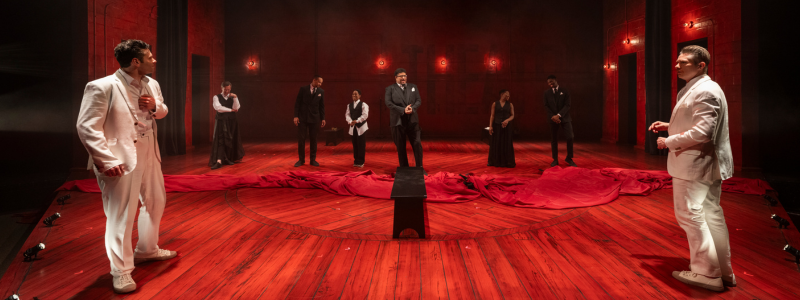Post-Show Writing Activity

Guide students through a creative writing activity using the Fish Out of Water structure and Tom Stoppard’s Rosencrantz and Guildenstern Are Dead as inspiration.
Though this activity is written for use in a classroom, it can be easily adapted for or used by learners of all ages.
Fish Out of Water Activity
- Activity Preparation
- Supplies:
- Small slips of paper (two per student)
- Fish Out of Water handout (one per student)
- Small receptacle, like a cup (two per group) (optional)
- Set-Up:
- Divide students into groups of four. Ensure that each student has two small slips of paper.
- Note that students will be pooling their papers together into two sets. This is where a receptacle like a cup may come in handy. Alternatively, provide two different colors of paper, and have students write their people on one color and settings on the other.
- Supplies:
This activity will take approximately 55 minutes.
- Learning Sequence
- Explain that in this activity, students will practice a kind of writing prompt that will challenge their creative thinking and storytelling. Ask: What does the phrase “fish out of water” mean?
- As needed, share that “fish out of water” refers to a person who is out of their element and usually feeling uncomfortable because of it. (~2 minutes)
- To activate prior knowledge, consider asking students to independently recall a time when they felt like a fish out of water. If students are willing to share, invite them to do so with a partner or with the class. (~2 minutes)
- Invite students to consider how the phrase “fish out of water” applies to Rosencrantz and Guildenstern Are Dead. (~2 minutes)
- Direct students to focus on their two pieces of paper. Tell them that they will be writing ideas to two separate prompts, one on each paper. Have students independently write the name of a character or person on their first slip of paper. This could be someone from history, popular culture, a book, a movie, etc. Ask students to fold these papers and put them in a pile. (~2 minutes)
- Have students write a setting, time period, or historical event on their second piece of paper. This should be unrelated to the person that each student chose. Have students put these papers into a separate pile. (~2 minutes)
- Direct one person from each group to select a piece of paper from the People pile. Prompt groups to discuss what setting this person or character might feel most at home within — their water, to continue the fish metaphor. (~3 minutes)
- Have students select a paper from the Settings pile. Prompt them to discuss how the character they selected might feel if they found themselves in the selected setting. (~5 minutes)
- Prompt students to repeat these steps three more times until all People and Settings have been discussed. (~15 minutes)
- Transition students from small groups to independent work. Have students turn to their Fish Out of Water handout. Prompt them to pick a person (either one that came up in their group, or an entirely new one of their choosing) and a setting (again, either one from group discussions or a brand new one). Then, have students spend some time brainstorming in response to the listed questions. (~7 minutes)
- Who might this person encounter in this setting?
- How do they fit in? How do they not?
- How does this person feel in this setting?
- What experience, interaction, or moment do you want to explore?
- Explain that in this activity, students will practice a kind of writing prompt that will challenge their creative thinking and storytelling. Ask: What does the phrase “fish out of water” mean?
- Once students have had a chance to brainstorm, direct them to spend some time writing a narrative about their chosen person in the setting; they may format their story however they wish. Remind students that their narrative should in some way aim to capture or explore the character’s experience with being new to or unfamiliar with the setting they chose. If time allows, consider inviting students to share a bit about their stories. (~15 minutes)
- This activity addresses the following standards:
- Illinois Arts Learning Standards
- Anchor Standard 1: Generate and conceptualize artistic ideas and work.
- Anchor Standard 2: Organize and develop artistic ideas and work.
- Common Core State Standards
- CCSS.ELA.W3 Write narratives to develop real or imagined experiences or events using effective technique, well-chosen details, and well-structured event sequences.
- CCSS.ELA.W4 Produce clear and coherent writing in which the development, organization, and style are appropriate to task, purpose, and audience.
- Illinois Arts Learning Standards